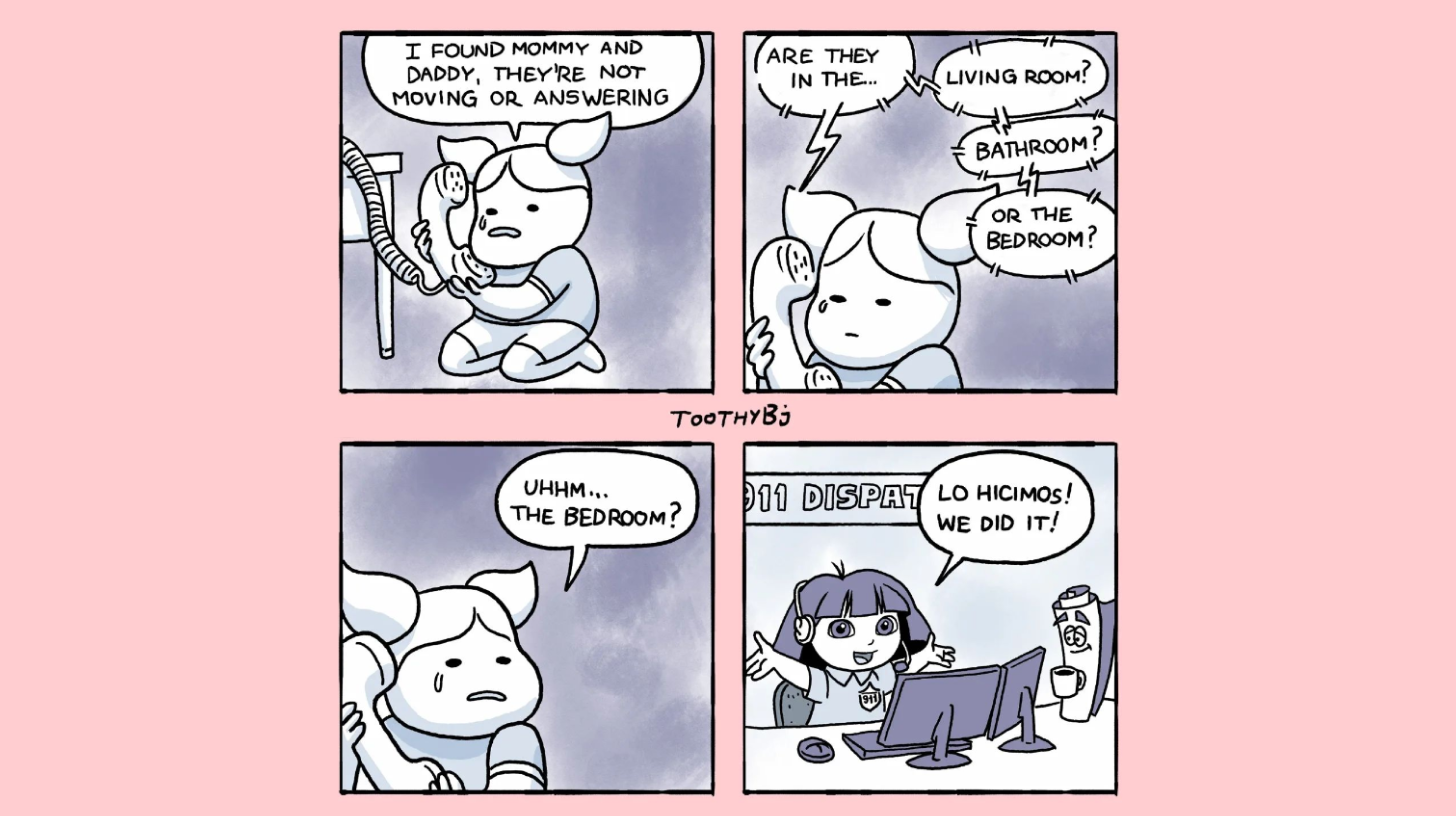What Constitutes a Sense of Humor?
A sense of humor involves an innate grasp of what elicits laughter and what doesn’t. Someone possessing a well-developed sense of humor may express amusing thoughts and perceive humorous aspects that others might overlook.
Absolutely! Being “humorous” doesn’t necessarily entail crafting five jokes in five minutes. Opting for laughter five times within the same timeframe could be just as effective! Explore Merriam-Webster’s elucidation of a “sense of humor”:
- You are likely to deliver universally appealing jokes in appropriate contexts, discern when to jest and when to maintain seriousness;
- You find amusement in the comedic endeavors of others.
Both these approaches can be incorporated using the following suggestions.
How to Cultivate a Sense of Humor
Recall how Picasso emulated numerous “conventional” artists before pioneering his abstract style? Developing a sense of humor follows a similar trajectory—it commences with observing exemplary instances.
Step 1. Embrace Humor Consumption
Engage with humorous content from comedy films, talk shows, and Saturday Night Live. Endeavor to discern the 12 types of humor within them, memorize notable one-liners, and pinpoint the specific comedic styles that resonate with you. For instance, if Sofia Vergara’s humor appeals to you the most, immerse yourself in her interviews and delve into the “Sofia Vergara World.”
Step 2. Familiarize Yourself with the 12 Types of Humor
Explore all 12 humor types below and select one or two that particularly align with your preferences.
Subsequently, practice diligently. Despite the synthesis, distillation, and simplification of these tips, their integration into your life requires hands-on application. After 2 or 3 attempts, these techniques will become ingrained in your persona.
Throughout this journey, you’ll gain a profound understanding of what triggers laughter and discern which humor styles resonate with you the most.
Eager to discover your laughter type? Watch our video for insights!
If you aspire to master the art of humor, even if you weren’t inherently funny, peruse our How to Be Funny article! It presents seven easily applicable tips distilled from the analysis of numerous talk shows, providing everyone with the tools to inject humor into everyday situations.
The Diverse Spectrum of Humor: Exploring 12 Types
Humor manifests in various forms, each with its distinct appeal. Familiarizing yourself with these diverse types not only helps you pinpoint your preferences but also equips you with the ability to deploy the appropriate form in different situations. Additionally, it provides insight into others’ comedic perspectives, enabling you to comprehend the humor they convey and anticipate laughter-inducing moments.
Embark on a quick exploration of several humor categories with us!
Self-Deprecating Humor: A Lighthearted Jab at Yourself
Injecting humor by poking fun at your own quirks can project an image of self-awareness and quick wit.
This comedic style serves as a splendid avenue to convey approachability and humility. Instances may involve playful mockery of personal traits like clumsiness, forgetfulness, or even the occasional questionable haircut.
Jennifer Lawrence epitomizes the mastery of self-deprecating humor. In a noteworthy example, she humorously depicted a situation where her intestine was bleeding, framing it as a bizarre blessing and showcasing her penchant for embracing the eccentric. Watch the example here.
While employing self-deprecating humor can be an effortless and inoffensive way to craft a good joke, moderation is key. Ensure that you strike a balance and exude confidence in delivering the jest.
Pro Tip: Exercise caution when using self-deprecating humor related to a significant weakness. In professional settings that value leadership, making light of your leadership skills might not be the most advisable approach.
Self-Enhancing Humor: Transforming Teasing into Triumph
In the realm of humor, self-enhancing humor stands out as the art of interpreting potentially unkind remarks as compliments.
While not as widely recognized as self-deprecating humor, self-enhancing humor can be a potent tool, particularly when faced with teasing that may be pushing boundaries. Embracing this form of humor involves turning jests into affirmations, a skill that can be remarkably effective.
Sofia Vergara adeptly employs self-enhancing humor, especially in response to teasing about her accent. In a notable example, when Chelsea “complained” about Sofia’s accent, Sofia cleverly treated it as a compliment, retorting, “So jealous of my accent!” Watch the example here.
This use of self-enhancing humor not only diffused a potentially awkward situation but also showcased Sofia’s confidence and positivity.
While it’s essential to avoid excessive self-promotion, the occasional deployment of self-enhancing humor can be powerful, especially when confronted with playful banter.
Here are a couple of ways to try it in person:
- When someone says, “So glad you could come,” respond with, “Me too. I was hoping you would look forward to seeing me.” Follow it with a laugh and a light-hearted “just kidding.”
- If someone compliments you, react with apparent nonchalance and jest, saying, “I thought you would like that.”
Deadpan or Dry Humor: Mastering the Art of Understated Wit
In the comedic landscape, dry humor holds versatile appeal, owing to its laid-back tone.
The crux of understanding dry and witty humor lies in the delivery: the intentional disparity between a humorous remark and an utterly impassive facial expression and tone.
Ryan Gosling epitomizes the mastery of deadpan humor, seamlessly blending it with his storytelling prowess. Renowned for narrating amusing anecdotes with an entirely straight face, Gosling’s comedic finesse shines through. Witness an example here.
Observe how, during moments of uproarious laughter from the audience at phrases like “It’s a cut-throat business,” “They were the ones to beat,” and “Twins from the shining,” Ryan maintains an unwaveringly serious demeanor.
Pro Tip: When recounting a well-known and inherently funny story, deliberately maintaining a deadpan expression can amplify the comedic impact. This technique is particularly effective for individuals with logical and analytical personality traits.
Deadpan or dry humor’s understated charm ensures its applicability across a spectrum of situations.
Laugh-at-Life Humor: Embracing the Lemonade Philosophy
Operating on the premise of “when life gives you lemons, make lemonade,” laugh-at-life humor proves to be an often overlooked gem in the comedic repertoire.
This approach serves as an underrated yet powerful tool in the humor toolkit. The key lies in training oneself to emotionally detach from challenging situations and discover a lighter perspective. Alternatively, one can offer a general comment on life inspired by the prevailing circumstances.
Rebel Wilson stands out as a master practitioner of this particular brand of humor. Her ability to find amusement in life’s quirks and challenges showcases the potency of laugh-at-life humor.
Dark Humor: Navigating the Edges of Comedy
Dark humor, while not inherently offensive, often encompasses examples that may be perceived as such.
This comedic style delves into taboo subjects like death and violence, which can potentially be considered offensive or unsettling. A key consideration to prevent triggering discomfort is to avoid discussing taboo topics related to specific individuals or situations that may hit too close to home.
The comic below, created by @Toothy.Bj, serves as an illustration of dark humor that doesn’t rely on shock factors or aggression towards any particular group.
Anecdotal Humor: Embracing Levity in Everyday Stories
Rather than striving to be funny, aim to be fun. While being funny might feel like a weighty task, being fun is more approachable.
Stanford Professors suggest that the pursuit of levity might be even more significant than the pursuit of outright humor. Levity is a mindset—an innate disposition toward and quest for joy.
Incorporate anecdotes from your life that elicit laughter. Perhaps you recently endured a flight with a snoring seatmate or witnessed your boyfriend gaining 30 pounds during the pandemic.
Share these amusing experiences with your friends! The essence of developing a sense of humor lies in bringing joy not only to yourself but also to those around you.
Satirical Humor: Illuminating Human Quirks and Foibles
Satirical humor, often characterized by its playful jabs at human idiosyncrasies and flaws, tends to elicit laughter with the notion, “It’s funny because it’s true” or “Funny equals Truth plus Pain.” This form of humor has a knack for unveiling uncomfortable truths that many might prefer to avoid.
In the example provided by Rebel Wilson at BAFTA watch here, she swiftly captures the audience’s laughter by spotlighting a certain truth. Another illustration of satirical humor is the line, “I’m sorry to be late. I guess I didn’t want to come,” which slyly reveals a commonly unspoken truth.
It’s important to note that the effectiveness of satirical humor hinges on having the right audience. While such humor can be potent, ensuring your audience is receptive is crucial.
For instance, the “I guess I didn’t want to come” line might land well among friends or lighthearted colleagues but may not sit as well with a less humor-inclined boss.
Before unleashing your satirical wit, gauge your audience’s appetite to strike the right balance between amusement and avoiding potential discomfort.
One-Liner Humor: Crafting Concise Comedy
Humor, despite its brevity, doesn’t necessarily equate to simplicity.
The realm of one-liner humor, as the name implies, thrives on succinctness, making it an ideal medium for encapsulating perspectives on significant topics like life, relationships, and money. Renowned writers, in particular, have mastered the art of one-liners, distilling wit and wisdom into a single line.
Oscar Wilde, for instance, left behind a trove of memorable one-liners:
- “Be yourself; everyone else is already taken.”
- “I have the simplest of tastes. I am always satisfied with the best.”
- “I am not young enough to know everything.”
Keep an ear out for clever one-liners in books, talk shows, and movies. Consider maintaining a collection in a notebook—you never know when one might come in handy, especially when acknowledging that you’re not young enough to know everything.
Slapstick Humor: Elevating Laughter through Physical Mischief
Slapstick serves as a creative avenue for deriving humor from physical actions and gestures.
In its essence, slapstick comedy revolves around exaggerated physical activities, such as comically slipping on banana peels or delivering a face slap with a fish. (Fun fact: Ancient Greeks did indulged in similar antics, providing a historical justification for the occasional slap. You’re welcome.)
An iconic figure in slapstick comedy, Charlie Chaplin, showcased his mastery in silent films with impeccable timing and physicality watch here. https://youtu.be/_0a998z_G4g
But how do you translate this humor into real-life situations, and is being stuck in a cage with a lion the most hilarious icebreaker for a first date?
Ann Hale, an anthropologist from the University of Sydney, our affinity for slapstick humor lies not in the potential for injury but in our reaction to it. The way someone strives to maintain balance on a tightrope creates a different visual impact compared to someone merely standing on solid ground. The humor emerges from contextual mismatches.
To apply slapstick humor in real life, consider the following elements:
- Physical movements, and
- A deliberate mismatch.
Watch this clip of Jackie Chan here. Notice how people instinctively move their hands in a particular way when hearing Jackie Chan’s name. Jackie introduces a mismatch by replicating the same move when mentioning Robert De Niro—creating a slapstick moment.
Pro Tip: Engage your entire body to express humor, especially when a physical action carries strong expectations. Overturn those expectations by executing the move while introducing intentional mismatches, such as unexpected names, locations, or timing.
Hyperbolic Humor: The Art of Exaggeration
In the realm of humor, it’s not just about what you say but how you say it—show, don’t just tell.
Having a sense of humor often involves mastering the nuances of delivery: the tone, the gestures, the expressions.
A prime example of hyperbolic humor is demonstrated by Will Ferrell. In the provided example watch here, upon discovering Blake Lively’s fondness for him, he elevates the humor by exaggerating his tone and voice, effortlessly eliciting laughter.
Next time you share a story or respond to a comment, consider incorporating action and exaggeration. It’s a remarkably simple yet effective way to convey humor and leave a lasting impression.
Callback Humor: The Art of Referential Laughter
A callback, in the realm of humor, involves referencing a previously shared joke.
This form of humor is widely embraced and particularly beginner-friendly. An illustrative example involves Julia Roberts teasing David Letterman about having a son when they were unmarried. Following the initial “not married” joke, Roberts adeptly incorporates callbacks multiple times in subsequent conversations.
The brilliance of callbacks lies in their enduring quality—once a joke is introduced, it can persist as a humorous reference throughout various interactions, potentially gaining even more comedic value over time.
If you aspire to enhance your comedic skills but find the art of joke-telling elusive, callbacks can be your trusted ally, seamlessly injecting humor into conversations.
Surprise & Incongruity Humor: Flipping Expectations for Laughs
Humor often thrives on the element of surprise, and Surprise & Incongruity humor takes this to the next level by intentionally setting up expectations only to completely overturn them.
In this comedic approach, expectations are artfully established, sometimes through adjectives and numbers, and then swiftly subverted, generating laughter in seconds. A prime example is provided by Mindy Kaling, who humorously described the cast of Ocean’s 8 by using the unexpected adjective “struggling” for a group of big-name celebrities watch here.
Numbers also play a crucial role in creating surprises. By manipulating expectations around quantities, such as making a tiny number seem enormous or vice versa, you can effortlessly generate laughs. Amy Poehler expertly employed this technique by initially implying a minuscule prize for the Master Makers competition and then surprising the audience with a substantial figure at the end watch here.
Benefits of Humor: A Powerful Catalyst for Success
Humor is not just a source of amusement; it intricately intertwines with various facets of life, offering a plethora of benefits such as competency, attraction, likeability, and intelligence.
The potency of humor goes beyond common knowledge.
An illuminating Robert Half International survey underscores the significance of humor in the professional realm, revealing that a staggering 91% of executives consider a sense of humor to be indispensable for career advancement.
Yes, you read that correctly—91%, not 19%.
In the realm of courtships, a study by Glenn Geher, Ph.D., revealed that men in the “humor” condition, those witnessed telling jokes, were nearly three times as likely to receive a phone number from female participants compared to their counterparts.
While managing unwanted attention may occasionally necessitate changing phone numbers, the potential benefits of humor seem to outweigh the drawbacks.
As a final testament to the power of humor, even the brilliant Albert Einstein attributed his wisdom to a childish sense of humor, emphasizing the profound influence of laughter on intellectual prowess.



